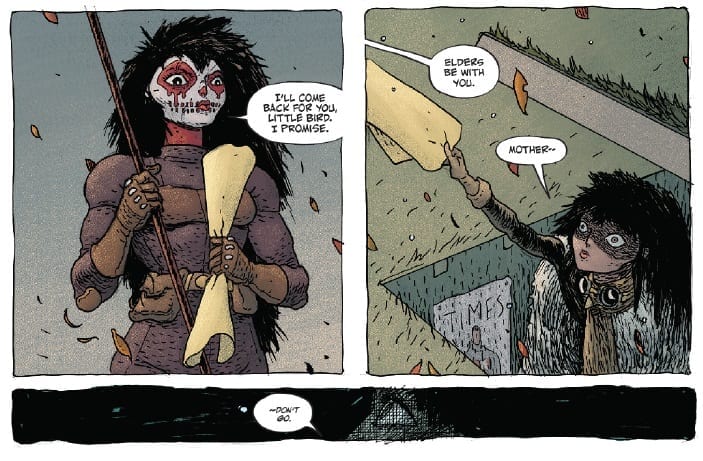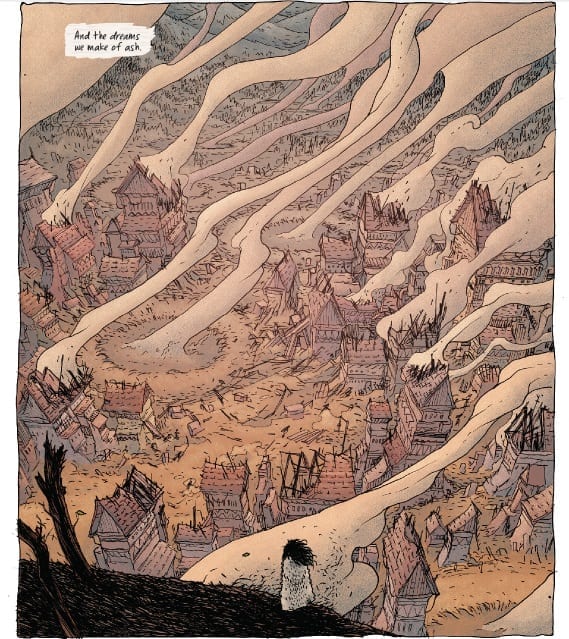Film maker Darcy Van Poelgeest and artist Ian Bertram (House of Penance) bring the tale of Little Bird to Image Comics. Set in a dystopian future where corrupt religion rules the land, a young girl faces the world with a desperate mission to save us all.
The collaboration introduces a disturbing world beautifully rendered in a style that is reminiscent of Nick Pitarra’s work on The Manhattan Projects. And just like that title, Little Bird is populated with innocent souls; corrupt officials; and a cast of emotional grotesques who fit the desolated world they inhabit.

Writing/Story
In Canada the resistance against the United Nations of America are set to make a stand. Tantoo, the leader of the group, places her child in a protective bunker and leaves her with details of ‘the plan’ in case she doesn’t return. And so begins Little Birds journey.
Darcy Van Poelgeest introduces a lot of concepts within this initial issue. He builds a fully realised world around a handful of characters and yet, at no point does it feel as though he is rushing through the story. As the narrative unfolds, through the eyes of the hero and the villain, the world is slowly introduced in a naturalistic flow. As each element of this dystopian future is required for the story, it is dropped effortlessly into the narrative.
For example, Little Bird finds a helmet with video playback built in. This shows her the preaching’s of the Bishop and in turn helps the reader to understand how the centre of power has shifted in this future. This introduces the villain of the story and also proves that in this America, Religion is King.
Despite the violence and destruction, the central theme of the story is Hope. Little Bird has an over powering sense of Hope which leads her from one encounter to the next. Her single minded belief is the driving force behind all of her actions. Van Poelgeest contrasts this against the complicated actions of the villains. Everything they do is so convoluted; unnecessary complicated. There are plans and schemes within larger plans. Little Bird’s plan is straightforward and simple. This comparison of purpose is the building blocks of this world.

Art
Bertram’s art is magical to behold. He has scratch thin lines and a design style that stands out in a crowd. There is an element of Frank Quitely about his work but he leans towards surrealist ideals with his design. Nothing is quite as it seems but it ultimately all makes some kind of sense.
There are many moments where Bertram creates panels within panels to emphasis the narrative. He uses a rough panel boarder which is barely visible, the white of the gutter marks the edges of his panels, but then creates stronger panel like shapes within the images themselves. Characters are constantly being framed, trapped in their own destiny as it were. Little Bird herself appears to be in a constant struggle between these defined boarders and wide open spaces.
The color work is a blend of naturalistic tones and garish colors. Matt Hollingsworth gives Bertram’s art depth and definition, imbuing each scene with emotional context.
Aditya Bidikar’s lettering highlights aspects of the characters, drawing the reader’s attention to them. He uses different fonts so that the readers will interact with the characters in different ways and he even changes the speech balloon shapes for some of the characters, namely the Bishops servants. These square edged balloons give the impression that these servant characters are unreal and unnatural which is the opposite of Little Bird’s caption boxes. This is another example of contrasting elements within the comic; a theme woven through each page.

Conclusion
Little Bird has a massive world in which to play in and Van Poelgeest introduces it to the reader in an engaging manner. He lays the ground work for an epic adventure but doesn’t skimp on characters. This is an engrossing first issue which will pull you right in. It looks divine and reads beautifully but also has the harshness that dystopian futures often bring.
There are moments of expression in Little Bird that elevate this comic above other ‘good against evil’ political tales. Thin, wide screen panels of contemplation inserted into the page add emotional reinforcement for the central character throughout her journey. They are like punctuation marks within a novel. This produces an overall reading experience much different from the majority of the titles on the shelves.
There is a lot to absorb in issue 1 and the potential for future storytelling is vast. Like Image Comics other hit, Saga, Little Bird gives the reader a world to explore with seemingly endless boundaries.
Little Bird is released on 13th March 2019.

